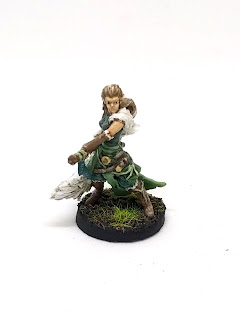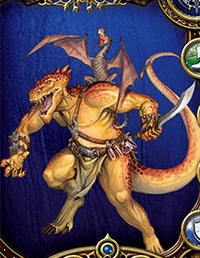 |
| Oblig. Box Art Photo. As per FFG/Runebound tradition, none of the pictured characters are in the box. |
In Sorastro's newer videos, he has been using zenithal priming, which is a form of pre-shading. This involves priming the figure black, then laying down a layer of grey primer from about 45 degrees, and then a layer of white primer from above. This looks like a nice way to start a model, but from what I understand, it requires an airbrush, and that's an investment I have not been willing to make. One of the main reasons I have avoided thinking about this is that it would require me to clean the garage workbench to make room for a spray station. Before he got into zenithal priming, however, Sorastro mentioned a technique in his Jain Fairwood video where he primes in white and then applies a thin wash over the model. The result is similar in spirit to zenithal priming: it pre-shades the recesses. I tried this, using my homemade ink wash based on Lester Bursley's recipe, starting with Avric Albright. The result was immediately recognizable as a failure. The Vallejo Surface Primer, when brushed on, has strange hyrdophobic properties. It's a bit like painting Bones plastic, if you've ever had that experience: the paint pulls into pools on the base coat, requiring multiple layers just to achieve coverage. I asked Ghool about this online, and he confirmed that this is how it goes with brush-on, although the same product behaves differently when airbrushed on. So, what happened with the ink wash was that it beaded up rather than flowing into recesses. I don't have any photographs of what happened to the miniature because I immediately grabbed a big brush of water and cleaned the stuff off the miniature as best as I could. There were still some faint ink tide marks, but these were easily covered by the real base coat.
There was another surprise regarding this new priming technique. Based on my experience with the attempted pre-shade, I knew I had to use thicker paint than usual to get good coverage on the base coat because of the strange primer properties. I painted a few heroes and the results were fine. About halfway through is when I interrupted this set to work on some others, and I used the same priming approach except that I used only one coat instead of two. On those models, the paint behaved much more nicely, without so much beading. I am still not sure if I am seeing a property of having used two layers of primer or something else about the plastic or the environment. I returned to spray priming for my next painting project since the weather was just right for it, but hopefully I can figure out all the variables here sometime.
OK, that's all the background and context. Let's move on to the figures!
I started with Leoric of the Book, the character I intended to use for our Road to Legend tutorial campaign. I am quite happy with the results, and I think it's some of my better work. Priming in grey, instead of the black gesso I have been using, made it much easier to get bright whites on Leoric's robes and tassels. Miniature painters know that eyes are troublesome; I watched Sorastro's video for inspiration and noticed that he didn't paint the eyes at all. I decided to do the same, and I think it gives the figure a great haughty expression, with his head tilted back, as if he's looking down his nose at some measly goblin archer.
Next up is Avric Albright, the cleric. I think I did a nice job with his cloak, and the checkerboard detailing on it really helps sell it. I spent some time on the shield trying to emphasize how light reflects off of metals, but it's really too subtle to show up here; using metallic paints (TMM, True Metallic Metals), it didn't really matter as much as if I was doing it without (NMM, Non-Metallic Metals). For Avric also, I did not paint his eyes, obscured as they are behind his helmet, and I think that was fine. Longtime readers may recognize that this is uncharacteristic for me not to paint the eyes at all. It's a small thing, but it was something interesting for me to consider.
My son played Syndrael, the elf knight, for our campaign. Of these three, she was the most straightforward to paint, since she's mostly gold armor and green cloth. The hardest part was matching the tones, which for the armor was done by mixing metallic gold paint with nonmetallic yellows and beige. Once again, no eyes, but with a slightly different stories. I painted the eyes on Syndrael, and they came out kind of buggy. Putting her next to Avric and Leoric, the difference was noticeable, so I ended up painting over them with flesh colors, leaving her with a somewhat distant facial expression.
I will make a quick note about the basing here, in case I ever need to come back to my own notes and base additional Descent figures. The bases were all done with a mix of fine, medium, and coarse ballast, about 4:2:1 ratio. This was painted black and drybrushed up to medium or light brown. Flocking was done with a 50/50 blend of burnt grass and medium green fine turf. I like how the turf suggests a combination of low-growing greenery, and on top of this, I added static grass to most of the heroes. A mix of green and black tea leaves was used for the rest of the flock; these were taken from teabags, which are finely cut and contain a nice assortment of tones and shapes.
My son wasn't so happy with Syndrael, so the next one I painted was Grisbane the Thirsty, the other warrior from the base set. I am quite happy with the results here too. Like all the figures, I didn't pick the paint scheme; I just tried to match what was on the character art. Still, I think his mix of reds and browns turned out great, contrasting against the grey hair and metallic highlights. I spent more time on his face than any other, glazing on a reddish hue to his nose and cheeks.
The first of the scouts from the base set is Tomble Burrowell. His color scheme is a lot like Grisban's, with reds, browns, and bright accents. I mentioned this in my previous painting post about the Visions of Dawn expansion, but it was kind of hard to be motivated to paint the scouts. For three players, I'm inclined toward a party that includes Fighter, Healer, and Spellcaster, which leaves Rogues out of the mix as an optional fourth. Maybe once this current campaign is done we'll try a different mix; although the Road to Legend app allows for multiple campaigns at once, that does require tedious swapping of cards, a process that drained a lot of my energy for Imperial Assault back when I finished that and tried running two campaigns at once. Honestly, I don't know if these Scouts will ever hit the table if the Imperial Assault co-op app is released before our Descent campaign is finished, since I'm hopeful that it will breathe new life into IA and allow me to bring those minis back to the table.
Let me leave myself a quick note here about these photographs. These were all taken in the morning (which means without direct sunlight into my office, which has south and west windows) from my lightbox. I used the same postprocessing that I mentioned in the Visions of Dawn heroes post, namely, that I boosted the whites using the Google Photos "white" slider in their Web-based image editor. I believe that these photos are quite good representations of the actual miniature.
After finishing the Road to Legend mini-campaign, my wife and son were switching to characters from Visions of Dawn for the full campaign. I thought about keeping Leoric since I quite enjoyed him, and I was not so interested in the abilities of Master Thorn—the Mage from Visions of Dawn. Returning to the base set, I realized that Widow Tarha could be a fun character to play as a Runemaster, so I painted her up, and it's been a blast. Her re-roll ability is priceless, especially with the 1/6 chance of a miss that plagues Descent (and was cleverly shifted away to a defensive ability in Imperial Assault). I think the fiture turned out quite nice, with a lot of contrast between the colors. Perhaps I could have taken her skin highlights up higher, since it does look a bit dull compared to the rest of her. The fur headdress was painted bright white and then toned down with a series of washes. Again, in retrospect, I could have done something more elegant here by blending different base colors on the headdress and then using washes to unite the colors; I'm sure this perspective is influenced by some of Sorastro's latest videos where he uses this approach on classic Star Wars characters such as the Rancor and Jabba the Hutt.
Here is the other scout: Jain Fairwood. Despite my uncertainty about the future of these scouts, I do think that the result is good here. In retrospect, I could have probably taken the highlights on the cloak and hair even higher. I had a hard time with the part of her cloak that falls down over her back since it is rather flat. It took several layers of highlights and base color glazes to get something I deemed acceptable. The final effect is somewhat mottled, which is an artifact of having done an ad hoc mix of layering, wet blending, and feathering.
Finally, here's Ashrian, who I painted last, giving her the unenviable position of "I'm ready to be done" paint job. Her pose is quite dynamic and interesting, but the either the sculpt was sloppy or the casting was poor. She was covered in awkward, unreachable mold lines, including across the middle of her hair. I think I have mentioned before that I believe Descent can be credited with some of the growth of miniature board games and the painting hobby, leading to the massive success of Kickstarter projects like CMON's, It seemed to me like the average quality of the Visions of Dawn miniatures was much higher than the base set characters; is this a reflection of Fantasy Flight's recognition of the value of hobbyist painters, or perhaps market-driven improvements in miniature production technology? I don't know that anyone has a definitive public answer, and I know that FFG is generally very quiet about their products and production.
In any case, Ashrian turned out fine. I could have added a bit more detail, but the result is a fair interpretation. The hair on the card art is a bit more yellow than I have here. Who will ever play her, though, when we have Ispher? Still, she passes my fitness function.
 |
| Let's go journey in the dark! |
I am glad I followed through with the idea of using the same fundamental technique for all the characters. I wasn't a zealot about it, using a bit of wet-blending or two-brush blending when it seemed appropriate. Base/wash/highlight worked well over the light grey primer. It's not clear that it saved me much time over working up from black primer except on those heroes with a lot of white showing, such as Leoric and Widow Tarha.
It's a good feeling to finish a set like this and know that I've created some interesting art that enhances my family's enjoyment of our boardgaming hobby. Thanks for reading!





































